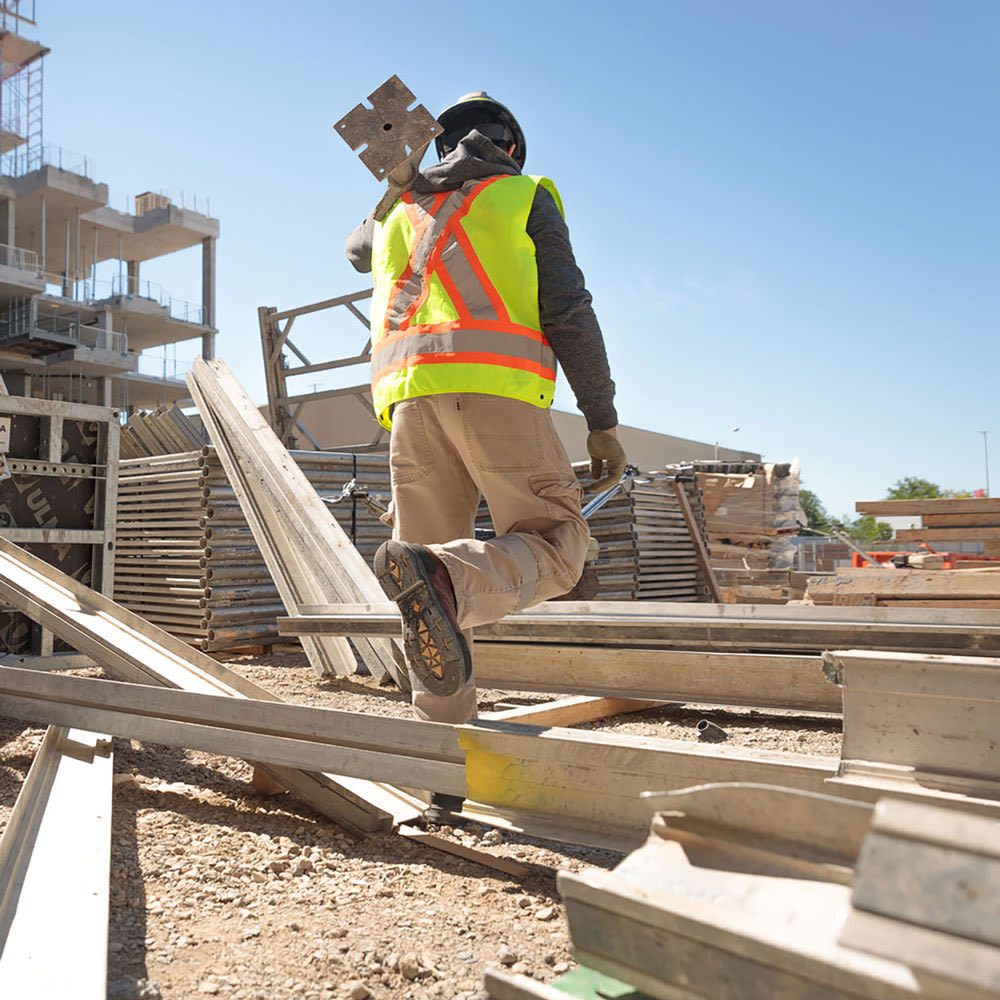
Construction work during hot weather poses many hazards. Hot weather can trigger heat-related illnesses, make it harder to concentrate and avoid potentially dangerous mistakes, and make it difficult to stay adequately hydrated.
To meet OSHA safety standards and stay cool, employees should follow hydration requirements while gradually acclimating themselves to the heat and wearing appropriate hot weather work uniforms.
What Are the Potential Hazards of Working Construction in Hot Weather?
Working in hot weather poses several dangers to construction workers. Risks include the following:
Heat exhaustion or stroke.
Dehydration.
Sunburn and skin damage.
Fatigue and reduced concentration.
Increased potential for accidents.
Exacerbation of existing health conditions.
What Is the Occupational Safety and Health Administration (OSHA) Safety Standards on Working Construction in the Heat?
By doing the following, OSHA plays an essential role in ensuring that employees have safe working environments by doing the following:
Setting and enforcing standards.
Offering training courses and education.
Performing inspections and investigations to monitor workplace hazards.
Promoting workplace safety.
OSHA does not set specific enforceable standards for working in hot environments, but it provides guidance for reducing the risks of heat-related illnesses. Here are a few key suggestions that OSHA offers industries in which employees must work in high heat:
Employers should implement a heat illness prevention program that includes worker education on heat hazards and mitigation methods as part of this initiative. Suggestion s for this program include prioritizing regular access to water sources for workers to stay hydrated during periods of extreme heat stress.
Employers must allow workers to have frequent rest breaks in shaded or cool areas, throughout their shift so they can rest and recharge. Workers should also have the opportunity to adapt gradually to hot environments by following work schedules that consider the hottest times of day.
Employers should encourage appropriate clothing selections and make sure that heat-reducing personal protective equipment (PPE) is available to all employees.
Protocols should also be in place for a swift response to heat-related illnesses, including prompt access to first- aid or emergency medical services if required.
How to Stay Cool on the Job
Construction workers face an elevated risk of heat-related illness because of their physically demanding jobs and extended exposure to hot temperatures and humidity, particularly during summer.
Certain tasks, such as working in poorly ventilated environments without air conditioning, can further exacerbate this threat. In these environments, it’s imperative that construction firms prioritize heat safety measures as early as possible to safeguard worker’s’ health and safety.
Dress Appropriately
In hot weather, light-colored clothing that fits loosely is best. Cotton is breathable, so it can work well, but moisture-wicking clothing helps the body cool faster in humid climates, where sweat evaporation may become challenging. Wear a hat to keep the sun off your face, ears, and neck.
Apply Sunscreen
Make sure to thoroughly apply sunscreen to any exposed areas. Choose a waterproof or sport sunscreen with a high sun protection factor (SPF) to ensure it can withstand sweat. Reapply the sunscreen every two hours.
Hydrate Regularly
Construction workers should consume fluids every 15 to 20 minutes on hot days. Although any liquid can be hydrating, making water the main source of hydration is best.
Signs of dehydration include dizziness, fatigue, dry mouth and eyes, dark or infrequent urine, and headache. If dehydration is suspected, stop and rehydrate as quickly as possible. Drink plenty of water, and eat foods with high water content, such as fruit.
Start Early
Temperatures typically peak in the late afternoon. To maximize productivity during the cooler hours of the day, start early.
Seek Shade
Schedule regular five-minute rest breaks out of the sun. Any time employees find themselves overheated or experiencing symptoms of heat stress, they should be able to take a break in a shaded area. If possible, provide access to an air-conditioned trailer or area where workers can cool down if needed.
Get Acclimated
Acclimatization should be implemented as soon as an employee returns from illness, vacation, or any extended absences from work. To acclimate, employees can start slowly by doing about half of their workload before gradually building it back up to full capacity over five to seven days. Doing this gives their bodies time to adapt to heat and vigorous activity.
Know the Signs of Heat-Related Problems
Stress, heat rash, cramps, exhaustion, and heatstroke are all heat-related illnesses that can occur on construction sites or in work environments where high heat is part of the equation. For this reason, it is vital that trained safety staff be on- site at all times to monitor workers and provide first aid if needed.
Alsco Uniforms Can Help Your Employees Stay Cool in the Heat
Alsco Uniforms has you covered when temperatures soar, with professional uniforms that are designed specifically to keep employees cool and comfortable in any industry. And our uniform cleaning service handles all the busywork.
From construction to hospitality, as well as any other field that requires high heat exposure while workers are on the job, we have suitable uniform options. Our choices range from lightweight shirts and pants to moisture-wicking polo shirts, cooling accessories and high visibility workwear.
We also offer high-visibility uniforms and safety clothing that can partner well with hot weather options for construction workers and others who work outside. With the right combination, you can ensure that employees stay cool while being highly visible to prevent accidents and injuries. Reach out to us today to learn more about our offerings.
References
Ultraviolet (UV) Radiation and Sun Exposure. (July 2022). United States Environmental Protection Agency.
Heat Illness Prevention Campaign. Occupational Safety and Health Administration.
Heat Illness: Prevention, Symptoms & Treatment. (April 2021). Cleveland Clinic.
Treatment and Prevention of Heat-Related Illness. (October 2022). The New England Journal of Medicine.
Exertional Heat Stroke: Pathophysiology and Risk Factors. (2022). BMJ.
